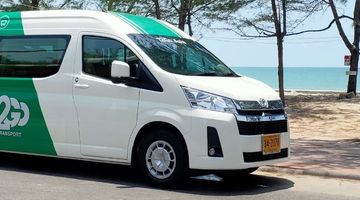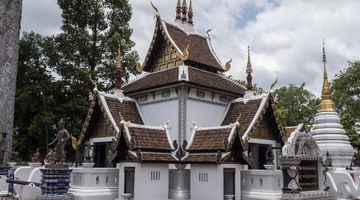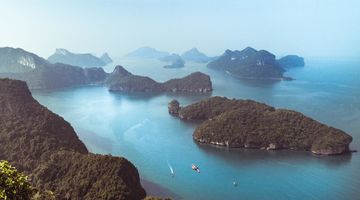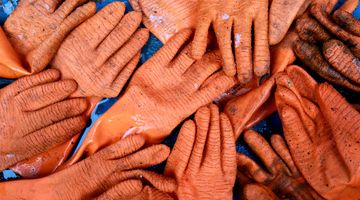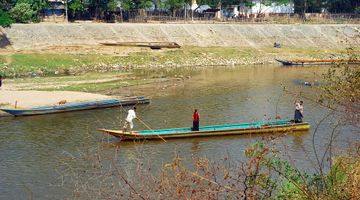Satun Travel Guide
In a nutshell
Satun is a small town with a population of roughly 22,000 people and it’s the capital of the homonymous province.
Why go to Satun
Satun province is one of the Southern provinces of Thailand, and even if it’s not a primary destination for Western tourists, many people will travel through Satun without even knowing it, on their way to some of the most beautiful islands of the Andaman sea.
Bordering with Malaysia, Satun has always been part of the Malay State of Kedah, and only in 1909 it became part of Thailand. As a result, the vast majority of the population in Satun are of the Malay origin and everything you are likely to see around there only proves that.
The main religion is Muslim, temples give way to mosques and wherever you go you will have no problem to find Halal food.
If you a have some spare time before getting to the islands, a couple of night in Satun will be a pleasant surprise. The city itself doesn’t have a lot of attractions but it’s still worth a visit to appreciate the cultural differences with the rest of Thailand.
If you’re a nature lover, do not miss Satun: the natural beauty of the province is simply stunning, with jungle covered mountains, lakes, waterfalls and forests, while the Satun islands are arguably some of the best ones in Thailand.
When to go to Satun
Best time of the year to visit Satun is definitely the dry season from October till May. During the rainy season (which is not too bad on the islands, to tell the truth) tropical storms hit the town and the rest of the province quite hard and because of the mountains which stretch all way along the provincial borders rains can last days after days.
A good time to visit the city is February when the Satun Kite Flying Competition takes place. For few days international and Thai competitors challenge each other in one of the biggest kite festival in South East Asia. At night cultural shows and performances rock the otherwise sleepy Satun.
Where to stay in Satun
Not too many accommodation options in Satun are available, but several guesthouses will do the trick for a couple of nights. No reservation is needed unless you’re visiting during the Kite Festival.
International tourism has never been massive in the city and the numbers of foreign visitors fell even more when several years ago the decision was made to move all the speedboats to Koh Lipe and Koh Tarutao from Tammalang Pier to Pak Bara, 50 km north of Satun.
Where to eat in Satun
Food should be one of the main reasons to stop in Satun for at least one night. The unique combination of Muslin and Thai recipes are the highlight of any visitor’s stay.
The lack of tourism means that foods are authentic and incredibly cheap and that people are super friendly doing their best to help you even if more than likely they won’t speak any English at all.
Something you will not find in Satun is western and international food chains like Burger King and Starbucks’s and in general western food will be hard to come across there.
How to get around in Satun
Satun centre is small enough to walk around on foot. Regular songthaews cross the town from North to South to Tammalung Port and cost THB30. Motorbike taxis and tuk-tuks can be found near the Mambang Mosque. If you’re planning to explore the natural beauties of Satun province, then a good option is to rent a car at Ang Yee's Guesthouse and Art Café.
How to get to and from Satun
Satun has neither an airport nor a train station.
The bus station is just out of town if heading south from the centre and regular songthaews and tuk-tuks will bring you there for few THB. On the same route, 9 km out of town, you’ll find Tammalung Pier from where ferries to Malaysian Langkawi depart.
From/to Bangkok
The two Satun closest airports are Hat Yai (90 km East of Satun) or Langkawi in Malaysia.
If you want to fly from Bangkok to Hat Yai check Nok Air for their fly’n’ride option which includes a flight to Hat Yai and a three-hour bus transfer from Hat Yai airport to Satun.
Several buses leave daily from Bangkok Southern Bus Terminal to Satun. There is a morning bus at 7am but all the rest are scheduled at after 3pm. The journey takes between 15 and 16 hours and tickets start at THB500. Price for Satun-Bangkok journey are the same with the majority of buses travelling by night.
If you want to travel by train the nearest train station is Hat Yai.
From/to Hat Yai
Hat Yai is a convenient layover hub for all travels down to the cities and destinations of the Thai Deep South – Satun included – and Malaysia.
Minibuses to and from Hat Yai depart every hour from the bus station in Satun. The journey takes 2 and a half hours and the fare is THB100. If you’re coming from Hat Yai to Satun, ask the driver to drop you off in the city centre and to save some time and money for a tuk-tuk ride back to town from the bus station.
From/to Koh Lipe
Koh Lipe is the biggest tourist destination in Satun province but surprisingly not only there is no boat service from Tammalong Pier anymore but in fact there’s even no direct transport to Pak Bara, which is now the main port for Koh Lipe.
If you need to get to Pak Bara, the only option you are left with is to get a minibus to Langu (THB50, every 20 minutes from the bus station) and tell the driver you’re heading to Koh Lipe. He will drop you off on the way to catch a songthaew to the port for THB20.
Another way to reach Koh Lipe is to take a ferry to Langkawi and from there hop onto the ferry back to Thailand.
From/to Langkawi
There are three daily ferries leaving Tammalong Pier (9.30am, 1.30pm, 4.30pm) for Langkawi in Malaysia. Tickets are THB 350 and the trip takes about two hours. Same price applies for travels back to Thailand (9am, 1 pm, 5pm).
From/to other destinations
The only other destinations from Satun are Trang (minivans leave every hour, THB105) and Phuket (three buses a day, THB350)
Is Satun a safe destination to visit?
Unlike other Southern Muslim provinces of Thailand Satun hasn’t been affected by protests and violence and can be considered a safe place to travel. People are extremely friendly, welcoming and ready to help those few foreigner tourists who venture to Satun. There is a hospital and a tourist office in the centre in case you need them.


